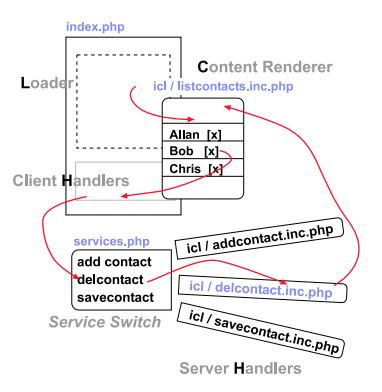The Loader-Content-Handler-Handler, or "LCHH", is a web programming architecture that is closely modeled after the HTTP request-response cycle and the 3-tier web structure.
As its name suggests, LCHH defines four key implementation components:
The Loader is an ID'ed DIV container that identifies a partial update region for later content injection;
The Content that contains both static information and interactive elements, also known as "Triggers";
Client-side Handlers that process various trigger events, such as button clicks;
Server-side Handlers that respond to AJAX requests that are sent by the client-side handlers. Server-side handlers typically perform database CRUD operations before piggy-backing the updated content into the aforementioned Loader.
LCHH uses the responseText of an XMLHttpRequest to replace the innerHTML value of the target DIV container. This is a common AJAX pattern. XHR injection alone, however, does not sum up LCHH. The "Content" in the initial loading of LCHH is instantly generated on the server-side as opposed to loading an empty container and then populating the container with another AJAX round-trip. Piggy-backing renewed content after database changes is also characteristic of LCHH.
LCHH organizes code into four categories:
Loader and Client-side Handlers (JavaScript functions) are stored in a "user-facing" file that is directly accessible by its URI;
A server-side script that can be included by the user-facing file. This script outputs the "Content";
A "routing script" that serves as a single point of call for invoking various AJAX calls;
Server-side handlers, typically stored under an "include" or "icl" sub-directory. Each handler is often implemented in a separate script file.

